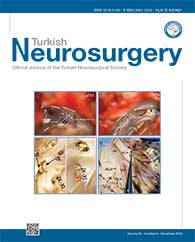2Marmara University, School of Medicine, Department of Physical Medicine and Rehabilitation, Pain Medicine Section, Istanbul, Turkey
3Istanbul Medipol University, Department of Radiology, Istanbul, Turkey DOI : 10.5137/1019-5149.JTN.44074-23.3 AIM: To investigate the relationship between epidural contrast spread patterns, and the treatment success of cervical interlaminar epidural steroid injection (CIESI) for cervical radicular pain.
MATERIAL and METHODS: A total of 76 patients aged between 20 and 60 years who had neck and unilateral upper limb pain due to a single-level disc herniation at C5-C6 or C6-C7 were included. Severity of pain and disability were assessed with Numerical Rating Scale (NRS-11) and Neck Pain Disability Scale (NPDS) at baseline, three weeks, and three months after the treatment. Contrast dispersion prior to injection of the medication was graded in anteroposterior fluoroscopic view. Treatment success was defined as a ≥50% improvement at three months in the NRS-11 scores compared to baseline.
RESULTS: A significant improvement in pain and disability scores was observed at three months compared to baseline (p<0.001). Treatment success was observed in 57% of the patients. The multivariate binary logistic regression analysis revealed that high initial NPDS scores, severe foraminal and central stenosis, Grade 1 contrast spread pattern were negative predictors of response to CIESI.
CONCLUSION: Lateral contrast spread toward the dorsal root ganglion (DRG) and spinal nerve root of the target level was associated with more favorable clinical responses. Clinicians performing CIESIs should exert effort to administer the injectate around the DRG and spinal nerve root at the target level.
Keywords : Cervical epidural injection, Contrast medium, Epidurogram, Injectate, Spread pattern




